Nestle's Information & Knowledge Management in the Food Industry
VerifiedAdded on 2023/06/11
|17
|4415
|317
Report
AI Summary
This report provides an in-depth analysis of knowledge management within Nestle, a leading food company. It highlights the critical aspects of knowledge management, its influence on Nestle's operations, and its importance in penetrating new markets. The report explores how Nestle aligns knowledge management with its information systems (IS) requirements and how the company leverages e-strategy and the internet to optimize its supply chain management, including inventory, purchasing, transportation, order processing, and procurement. Furthermore, it examines the role of Customer Relationship Management (CRM) systems in managing both tacit and explicit knowledge, including relationship capital, customer interactions, and supplier relationships. The report emphasizes Nestle's use of tacit knowledge gathered through customer engagement and its commitment to environmental sustainability and healthy eating habits. The document is available for students on Desklib, a platform offering a range of study tools and resources.

Running head: KNOWLEDGE AND INFORMATION
KNOWLEDGE AND INFORMATION
Name of the Student
Name of the University
Author Note
KNOWLEDGE AND INFORMATION
Name of the Student
Name of the University
Author Note
Paraphrase This Document
Need a fresh take? Get an instant paraphrase of this document with our AI Paraphraser
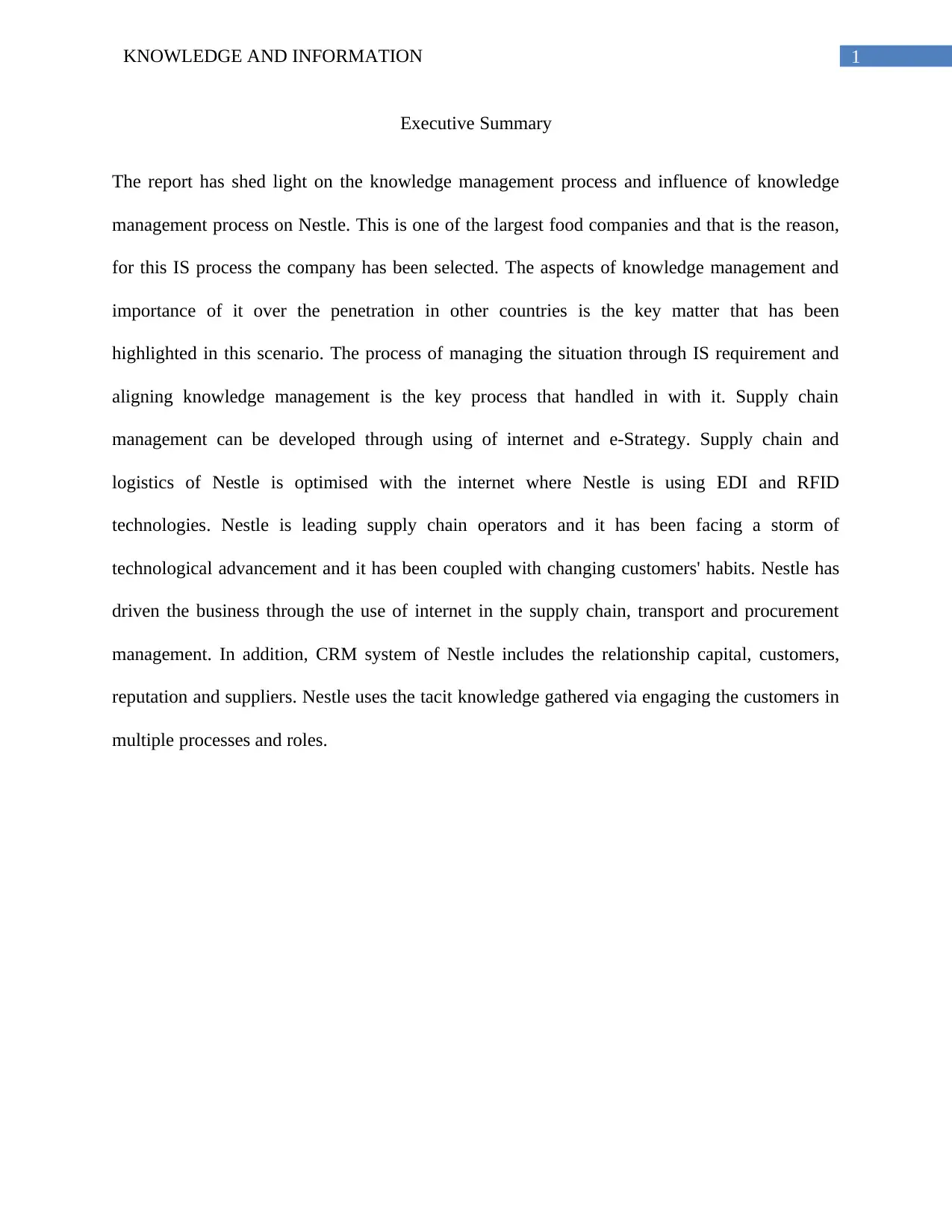
1KNOWLEDGE AND INFORMATION
Executive Summary
The report has shed light on the knowledge management process and influence of knowledge
management process on Nestle. This is one of the largest food companies and that is the reason,
for this IS process the company has been selected. The aspects of knowledge management and
importance of it over the penetration in other countries is the key matter that has been
highlighted in this scenario. The process of managing the situation through IS requirement and
aligning knowledge management is the key process that handled in with it. Supply chain
management can be developed through using of internet and e-Strategy. Supply chain and
logistics of Nestle is optimised with the internet where Nestle is using EDI and RFID
technologies. Nestle is leading supply chain operators and it has been facing a storm of
technological advancement and it has been coupled with changing customers' habits. Nestle has
driven the business through the use of internet in the supply chain, transport and procurement
management. In addition, CRM system of Nestle includes the relationship capital, customers,
reputation and suppliers. Nestle uses the tacit knowledge gathered via engaging the customers in
multiple processes and roles.
Executive Summary
The report has shed light on the knowledge management process and influence of knowledge
management process on Nestle. This is one of the largest food companies and that is the reason,
for this IS process the company has been selected. The aspects of knowledge management and
importance of it over the penetration in other countries is the key matter that has been
highlighted in this scenario. The process of managing the situation through IS requirement and
aligning knowledge management is the key process that handled in with it. Supply chain
management can be developed through using of internet and e-Strategy. Supply chain and
logistics of Nestle is optimised with the internet where Nestle is using EDI and RFID
technologies. Nestle is leading supply chain operators and it has been facing a storm of
technological advancement and it has been coupled with changing customers' habits. Nestle has
driven the business through the use of internet in the supply chain, transport and procurement
management. In addition, CRM system of Nestle includes the relationship capital, customers,
reputation and suppliers. Nestle uses the tacit knowledge gathered via engaging the customers in
multiple processes and roles.
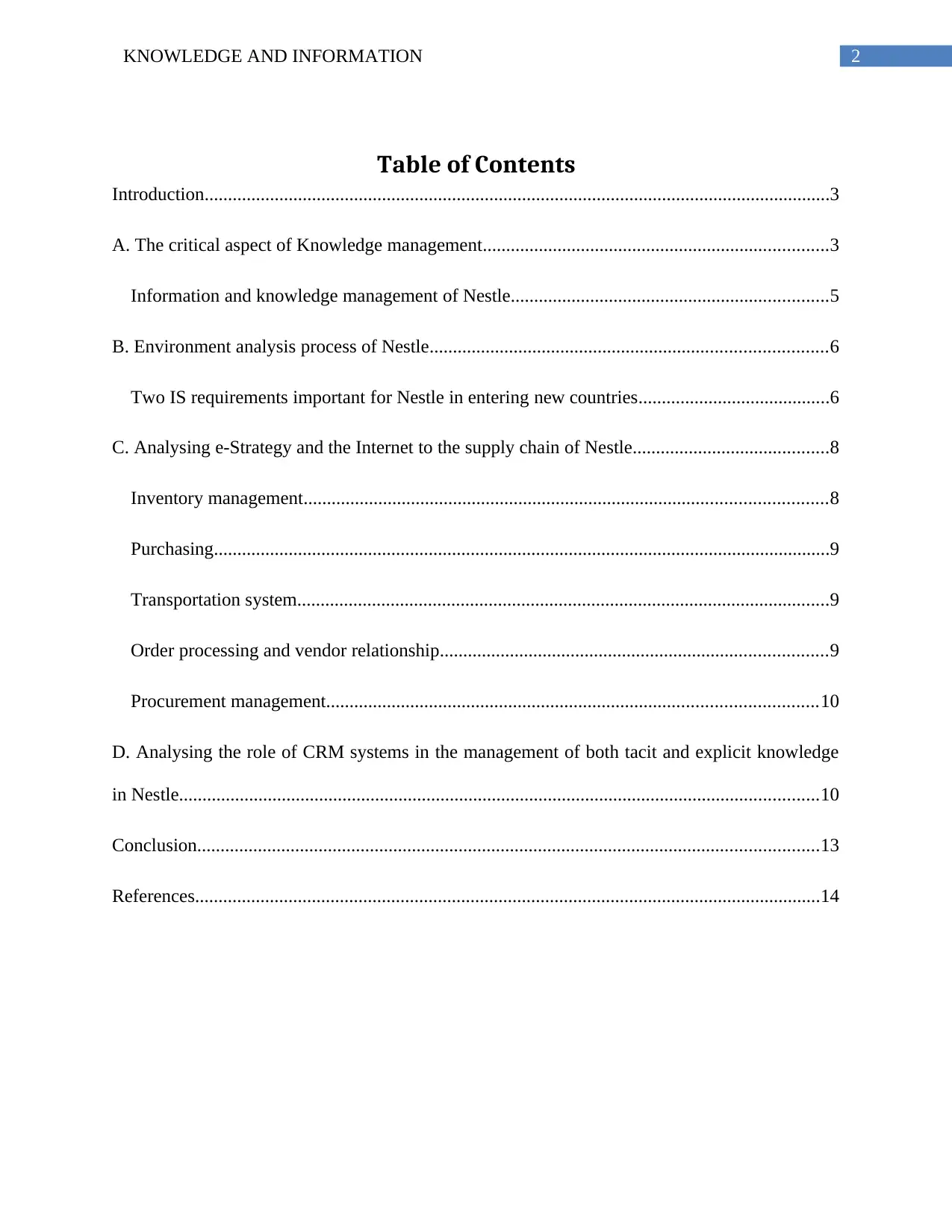
2KNOWLEDGE AND INFORMATION
Table of Contents
Introduction......................................................................................................................................3
A. The critical aspect of Knowledge management..........................................................................3
Information and knowledge management of Nestle....................................................................5
B. Environment analysis process of Nestle.....................................................................................6
Two IS requirements important for Nestle in entering new countries.........................................6
C. Analysing e-Strategy and the Internet to the supply chain of Nestle..........................................8
Inventory management................................................................................................................8
Purchasing....................................................................................................................................9
Transportation system..................................................................................................................9
Order processing and vendor relationship...................................................................................9
Procurement management.........................................................................................................10
D. Analysing the role of CRM systems in the management of both tacit and explicit knowledge
in Nestle.........................................................................................................................................10
Conclusion.....................................................................................................................................13
References......................................................................................................................................14
Table of Contents
Introduction......................................................................................................................................3
A. The critical aspect of Knowledge management..........................................................................3
Information and knowledge management of Nestle....................................................................5
B. Environment analysis process of Nestle.....................................................................................6
Two IS requirements important for Nestle in entering new countries.........................................6
C. Analysing e-Strategy and the Internet to the supply chain of Nestle..........................................8
Inventory management................................................................................................................8
Purchasing....................................................................................................................................9
Transportation system..................................................................................................................9
Order processing and vendor relationship...................................................................................9
Procurement management.........................................................................................................10
D. Analysing the role of CRM systems in the management of both tacit and explicit knowledge
in Nestle.........................................................................................................................................10
Conclusion.....................................................................................................................................13
References......................................................................................................................................14
⊘ This is a preview!⊘
Do you want full access?
Subscribe today to unlock all pages.

Trusted by 1+ million students worldwide
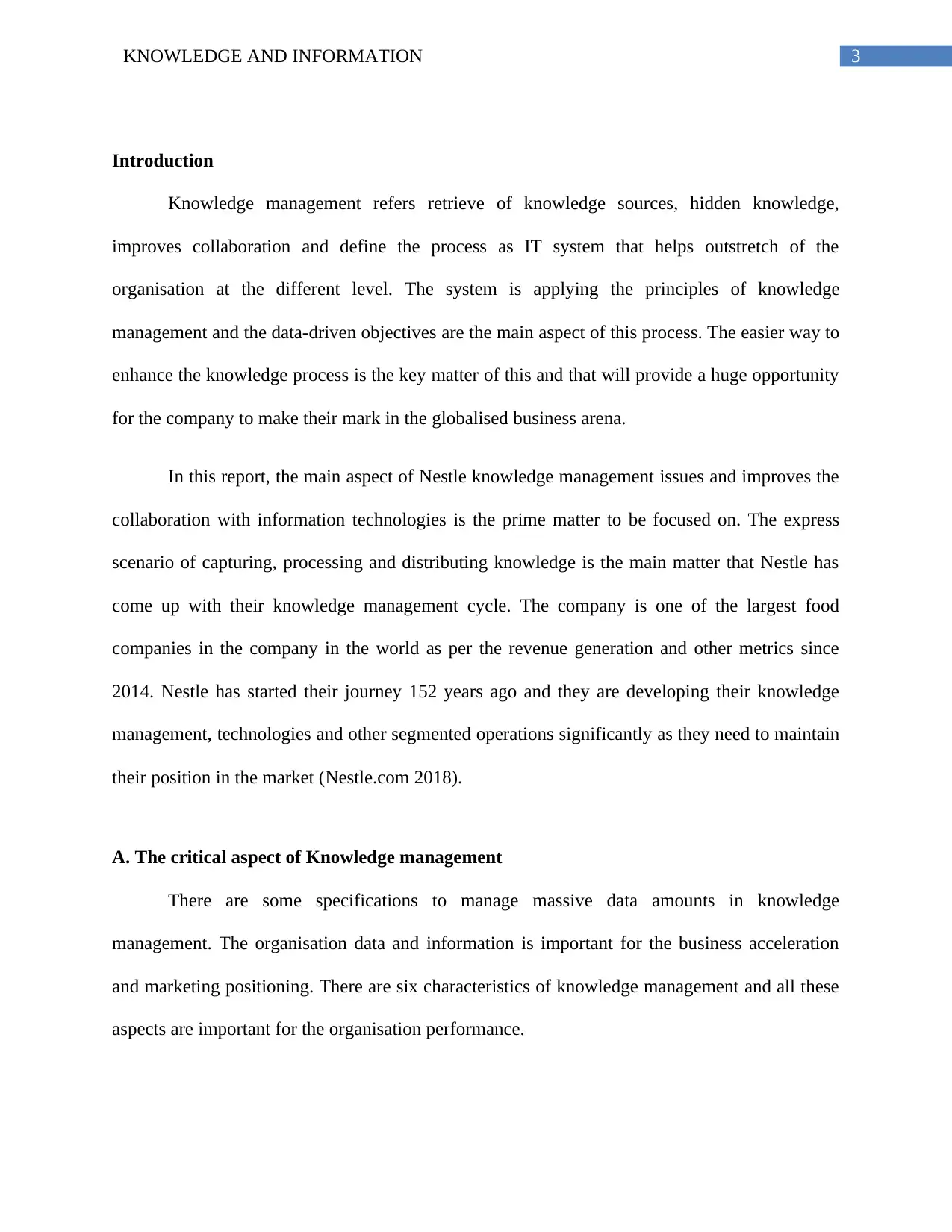
3KNOWLEDGE AND INFORMATION
Introduction
Knowledge management refers retrieve of knowledge sources, hidden knowledge,
improves collaboration and define the process as IT system that helps outstretch of the
organisation at the different level. The system is applying the principles of knowledge
management and the data-driven objectives are the main aspect of this process. The easier way to
enhance the knowledge process is the key matter of this and that will provide a huge opportunity
for the company to make their mark in the globalised business arena.
In this report, the main aspect of Nestle knowledge management issues and improves the
collaboration with information technologies is the prime matter to be focused on. The express
scenario of capturing, processing and distributing knowledge is the main matter that Nestle has
come up with their knowledge management cycle. The company is one of the largest food
companies in the company in the world as per the revenue generation and other metrics since
2014. Nestle has started their journey 152 years ago and they are developing their knowledge
management, technologies and other segmented operations significantly as they need to maintain
their position in the market (Nestle.com 2018).
A. The critical aspect of Knowledge management
There are some specifications to manage massive data amounts in knowledge
management. The organisation data and information is important for the business acceleration
and marketing positioning. There are six characteristics of knowledge management and all these
aspects are important for the organisation performance.
Introduction
Knowledge management refers retrieve of knowledge sources, hidden knowledge,
improves collaboration and define the process as IT system that helps outstretch of the
organisation at the different level. The system is applying the principles of knowledge
management and the data-driven objectives are the main aspect of this process. The easier way to
enhance the knowledge process is the key matter of this and that will provide a huge opportunity
for the company to make their mark in the globalised business arena.
In this report, the main aspect of Nestle knowledge management issues and improves the
collaboration with information technologies is the prime matter to be focused on. The express
scenario of capturing, processing and distributing knowledge is the main matter that Nestle has
come up with their knowledge management cycle. The company is one of the largest food
companies in the company in the world as per the revenue generation and other metrics since
2014. Nestle has started their journey 152 years ago and they are developing their knowledge
management, technologies and other segmented operations significantly as they need to maintain
their position in the market (Nestle.com 2018).
A. The critical aspect of Knowledge management
There are some specifications to manage massive data amounts in knowledge
management. The organisation data and information is important for the business acceleration
and marketing positioning. There are six characteristics of knowledge management and all these
aspects are important for the organisation performance.
Paraphrase This Document
Need a fresh take? Get an instant paraphrase of this document with our AI Paraphraser
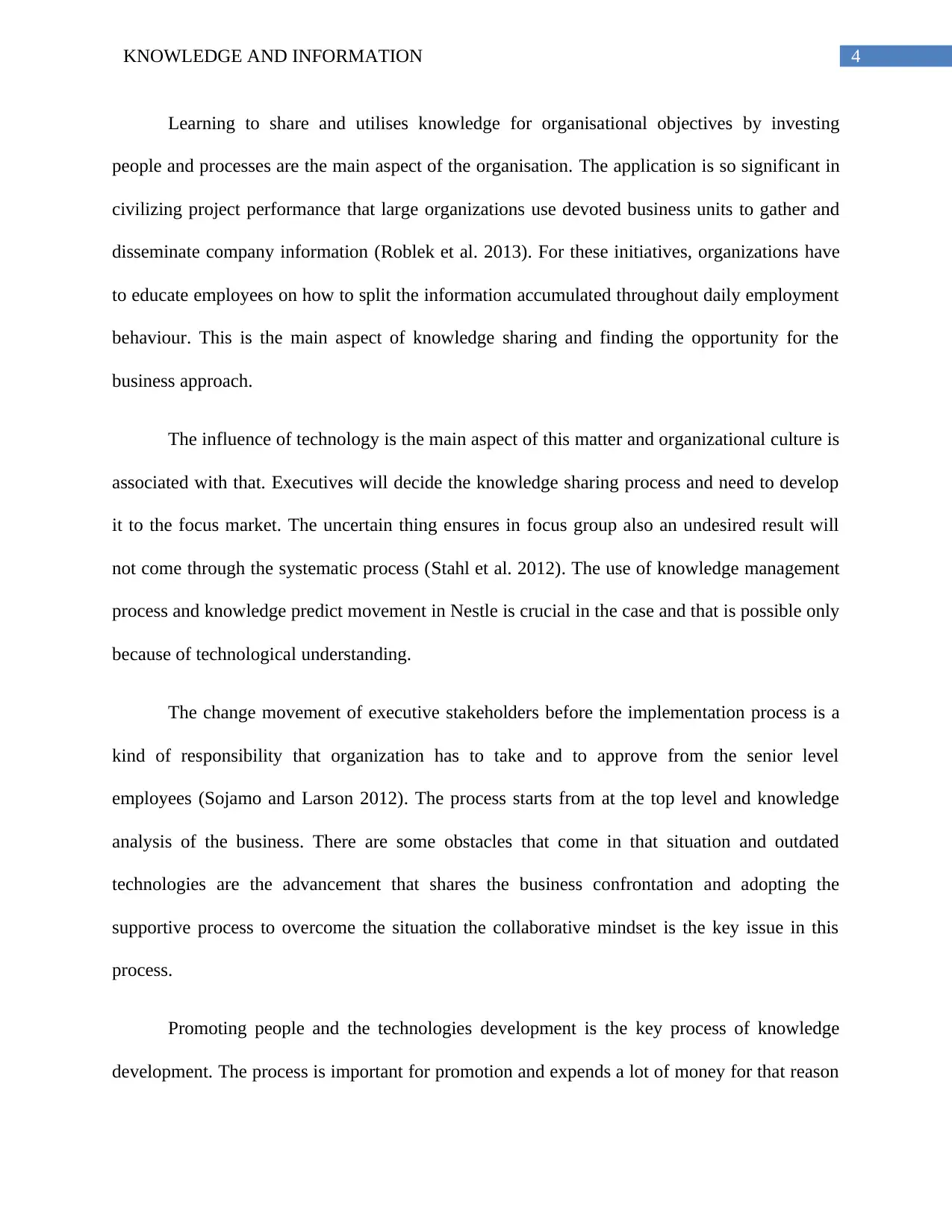
4KNOWLEDGE AND INFORMATION
Learning to share and utilises knowledge for organisational objectives by investing
people and processes are the main aspect of the organisation. The application is so significant in
civilizing project performance that large organizations use devoted business units to gather and
disseminate company information (Roblek et al. 2013). For these initiatives, organizations have
to educate employees on how to split the information accumulated throughout daily employment
behaviour. This is the main aspect of knowledge sharing and finding the opportunity for the
business approach.
The influence of technology is the main aspect of this matter and organizational culture is
associated with that. Executives will decide the knowledge sharing process and need to develop
it to the focus market. The uncertain thing ensures in focus group also an undesired result will
not come through the systematic process (Stahl et al. 2012). The use of knowledge management
process and knowledge predict movement in Nestle is crucial in the case and that is possible only
because of technological understanding.
The change movement of executive stakeholders before the implementation process is a
kind of responsibility that organization has to take and to approve from the senior level
employees (Sojamo and Larson 2012). The process starts from at the top level and knowledge
analysis of the business. There are some obstacles that come in that situation and outdated
technologies are the advancement that shares the business confrontation and adopting the
supportive process to overcome the situation the collaborative mindset is the key issue in this
process.
Promoting people and the technologies development is the key process of knowledge
development. The process is important for promotion and expends a lot of money for that reason
Learning to share and utilises knowledge for organisational objectives by investing
people and processes are the main aspect of the organisation. The application is so significant in
civilizing project performance that large organizations use devoted business units to gather and
disseminate company information (Roblek et al. 2013). For these initiatives, organizations have
to educate employees on how to split the information accumulated throughout daily employment
behaviour. This is the main aspect of knowledge sharing and finding the opportunity for the
business approach.
The influence of technology is the main aspect of this matter and organizational culture is
associated with that. Executives will decide the knowledge sharing process and need to develop
it to the focus market. The uncertain thing ensures in focus group also an undesired result will
not come through the systematic process (Stahl et al. 2012). The use of knowledge management
process and knowledge predict movement in Nestle is crucial in the case and that is possible only
because of technological understanding.
The change movement of executive stakeholders before the implementation process is a
kind of responsibility that organization has to take and to approve from the senior level
employees (Sojamo and Larson 2012). The process starts from at the top level and knowledge
analysis of the business. There are some obstacles that come in that situation and outdated
technologies are the advancement that shares the business confrontation and adopting the
supportive process to overcome the situation the collaborative mindset is the key issue in this
process.
Promoting people and the technologies development is the key process of knowledge
development. The process is important for promotion and expends a lot of money for that reason
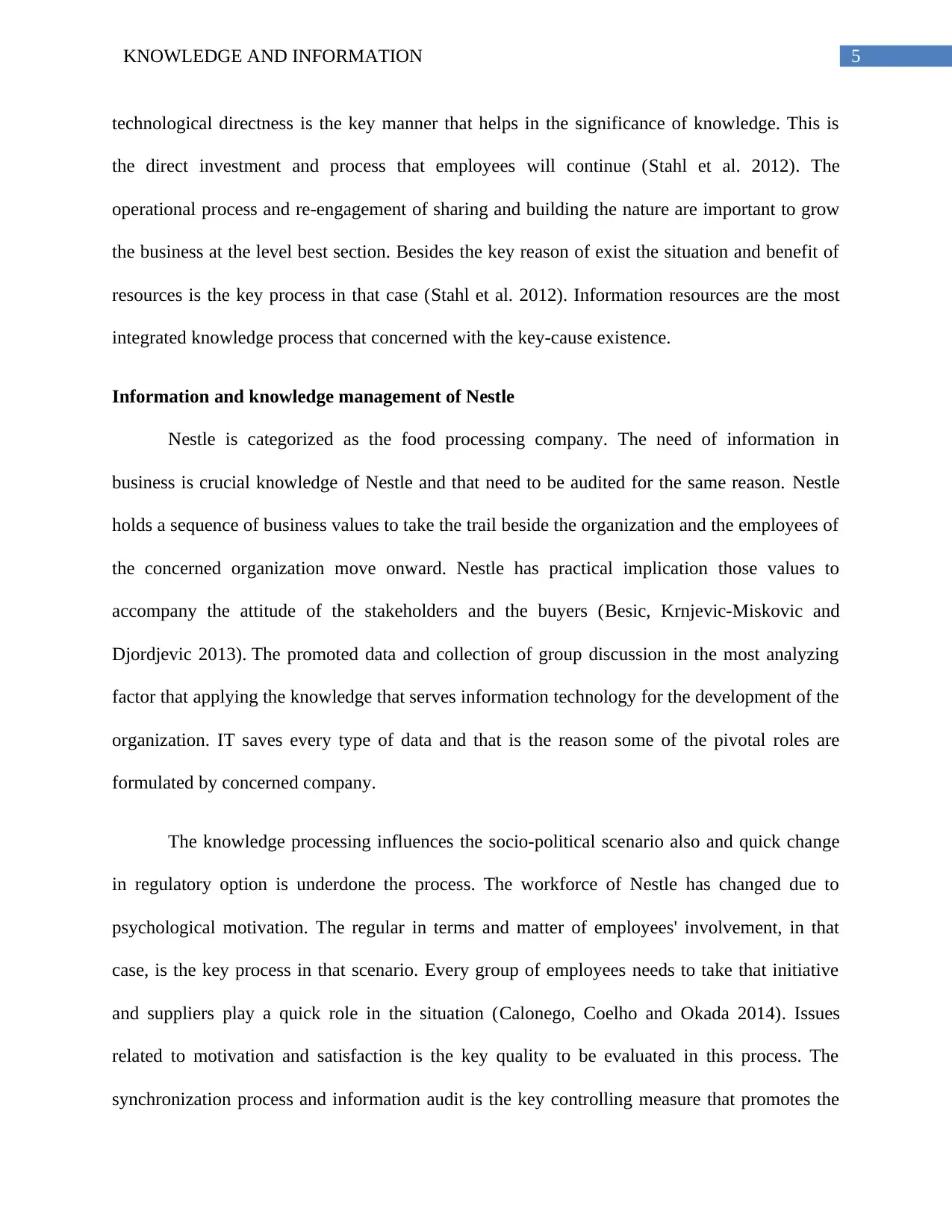
5KNOWLEDGE AND INFORMATION
technological directness is the key manner that helps in the significance of knowledge. This is
the direct investment and process that employees will continue (Stahl et al. 2012). The
operational process and re-engagement of sharing and building the nature are important to grow
the business at the level best section. Besides the key reason of exist the situation and benefit of
resources is the key process in that case (Stahl et al. 2012). Information resources are the most
integrated knowledge process that concerned with the key-cause existence.
Information and knowledge management of Nestle
Nestle is categorized as the food processing company. The need of information in
business is crucial knowledge of Nestle and that need to be audited for the same reason. Nestle
holds a sequence of business values to take the trail beside the organization and the employees of
the concerned organization move onward. Nestle has practical implication those values to
accompany the attitude of the stakeholders and the buyers (Besic, Krnjevic-Miskovic and
Djordjevic 2013). The promoted data and collection of group discussion in the most analyzing
factor that applying the knowledge that serves information technology for the development of the
organization. IT saves every type of data and that is the reason some of the pivotal roles are
formulated by concerned company.
The knowledge processing influences the socio-political scenario also and quick change
in regulatory option is underdone the process. The workforce of Nestle has changed due to
psychological motivation. The regular in terms and matter of employees' involvement, in that
case, is the key process in that scenario. Every group of employees needs to take that initiative
and suppliers play a quick role in the situation (Calonego, Coelho and Okada 2014). Issues
related to motivation and satisfaction is the key quality to be evaluated in this process. The
synchronization process and information audit is the key controlling measure that promotes the
technological directness is the key manner that helps in the significance of knowledge. This is
the direct investment and process that employees will continue (Stahl et al. 2012). The
operational process and re-engagement of sharing and building the nature are important to grow
the business at the level best section. Besides the key reason of exist the situation and benefit of
resources is the key process in that case (Stahl et al. 2012). Information resources are the most
integrated knowledge process that concerned with the key-cause existence.
Information and knowledge management of Nestle
Nestle is categorized as the food processing company. The need of information in
business is crucial knowledge of Nestle and that need to be audited for the same reason. Nestle
holds a sequence of business values to take the trail beside the organization and the employees of
the concerned organization move onward. Nestle has practical implication those values to
accompany the attitude of the stakeholders and the buyers (Besic, Krnjevic-Miskovic and
Djordjevic 2013). The promoted data and collection of group discussion in the most analyzing
factor that applying the knowledge that serves information technology for the development of the
organization. IT saves every type of data and that is the reason some of the pivotal roles are
formulated by concerned company.
The knowledge processing influences the socio-political scenario also and quick change
in regulatory option is underdone the process. The workforce of Nestle has changed due to
psychological motivation. The regular in terms and matter of employees' involvement, in that
case, is the key process in that scenario. Every group of employees needs to take that initiative
and suppliers play a quick role in the situation (Calonego, Coelho and Okada 2014). Issues
related to motivation and satisfaction is the key quality to be evaluated in this process. The
synchronization process and information audit is the key controlling measure that promotes the
⊘ This is a preview!⊘
Do you want full access?
Subscribe today to unlock all pages.

Trusted by 1+ million students worldwide
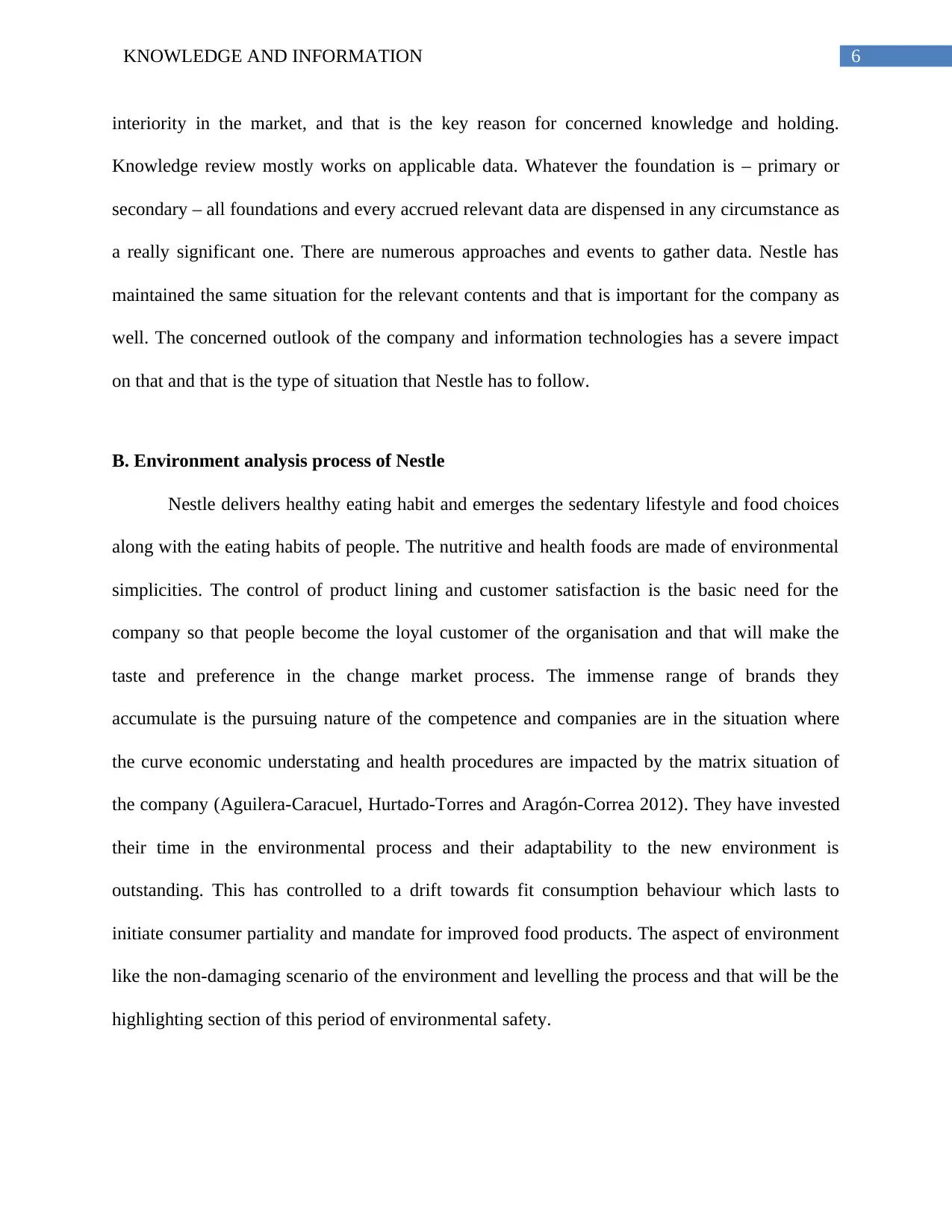
6KNOWLEDGE AND INFORMATION
interiority in the market, and that is the key reason for concerned knowledge and holding.
Knowledge review mostly works on applicable data. Whatever the foundation is – primary or
secondary – all foundations and every accrued relevant data are dispensed in any circumstance as
a really significant one. There are numerous approaches and events to gather data. Nestle has
maintained the same situation for the relevant contents and that is important for the company as
well. The concerned outlook of the company and information technologies has a severe impact
on that and that is the type of situation that Nestle has to follow.
B. Environment analysis process of Nestle
Nestle delivers healthy eating habit and emerges the sedentary lifestyle and food choices
along with the eating habits of people. The nutritive and health foods are made of environmental
simplicities. The control of product lining and customer satisfaction is the basic need for the
company so that people become the loyal customer of the organisation and that will make the
taste and preference in the change market process. The immense range of brands they
accumulate is the pursuing nature of the competence and companies are in the situation where
the curve economic understating and health procedures are impacted by the matrix situation of
the company (Aguilera-Caracuel, Hurtado-Torres and Aragón-Correa 2012). They have invested
their time in the environmental process and their adaptability to the new environment is
outstanding. This has controlled to a drift towards fit consumption behaviour which lasts to
initiate consumer partiality and mandate for improved food products. The aspect of environment
like the non-damaging scenario of the environment and levelling the process and that will be the
highlighting section of this period of environmental safety.
interiority in the market, and that is the key reason for concerned knowledge and holding.
Knowledge review mostly works on applicable data. Whatever the foundation is – primary or
secondary – all foundations and every accrued relevant data are dispensed in any circumstance as
a really significant one. There are numerous approaches and events to gather data. Nestle has
maintained the same situation for the relevant contents and that is important for the company as
well. The concerned outlook of the company and information technologies has a severe impact
on that and that is the type of situation that Nestle has to follow.
B. Environment analysis process of Nestle
Nestle delivers healthy eating habit and emerges the sedentary lifestyle and food choices
along with the eating habits of people. The nutritive and health foods are made of environmental
simplicities. The control of product lining and customer satisfaction is the basic need for the
company so that people become the loyal customer of the organisation and that will make the
taste and preference in the change market process. The immense range of brands they
accumulate is the pursuing nature of the competence and companies are in the situation where
the curve economic understating and health procedures are impacted by the matrix situation of
the company (Aguilera-Caracuel, Hurtado-Torres and Aragón-Correa 2012). They have invested
their time in the environmental process and their adaptability to the new environment is
outstanding. This has controlled to a drift towards fit consumption behaviour which lasts to
initiate consumer partiality and mandate for improved food products. The aspect of environment
like the non-damaging scenario of the environment and levelling the process and that will be the
highlighting section of this period of environmental safety.
Paraphrase This Document
Need a fresh take? Get an instant paraphrase of this document with our AI Paraphraser

7KNOWLEDGE AND INFORMATION
Two IS requirements important for Nestle in entering new countries
In case of the global information system, real-world features are important and that is the
reason Nestle utilises all the systems of IS in their latest technological vision. The process of
capturing, analysing, understanding, questioning, managing and integrates hardware process is
the key process in the view and that refers to the interpretation of real-world view (Roth et al.
2016). The trends in maps and globes are the main attraction of this process.
Transaction Processing System is the first IS requirement, which is needed for
penetrating another market. The process helps in producing the timely documents and reports.
The process of TPS helps in case of reduces cost and provides competitive advantages in this
case. The process also helps in case of selling products and provides customer satisfaction also.
In case of creating a base in an outer market, this is a kind of situation that needed for managing
the position of the company in the organization (Claver-Cortés, Molina-Manchón and Zaragoza-
Sáez 2013). Consumer purchase process and help in the case of consumer behaviour is being set
by the product analysis and transactional data processing system.
Inter-Organizational System is the best process to know the market and other
organisation. The knowledge about other organisation is important to know the situation they are
good in it and then implement a better strategy rather than these companies so that competitive
advantage will get through the process. The knowledge will grow as the new thinking and ability
or skill will grow up in the matter and that will evaluate the expansion of helping the manner
(Turner et al. 2016). This is the good process to overcome the weakness of the company and
deliver business for the better option. In case of a change in the company and team, the
employees are under the same team will help to continue the process and that is the easier way to
know the situation and section of work culture in other business. The making of this process is
Two IS requirements important for Nestle in entering new countries
In case of the global information system, real-world features are important and that is the
reason Nestle utilises all the systems of IS in their latest technological vision. The process of
capturing, analysing, understanding, questioning, managing and integrates hardware process is
the key process in the view and that refers to the interpretation of real-world view (Roth et al.
2016). The trends in maps and globes are the main attraction of this process.
Transaction Processing System is the first IS requirement, which is needed for
penetrating another market. The process helps in producing the timely documents and reports.
The process of TPS helps in case of reduces cost and provides competitive advantages in this
case. The process also helps in case of selling products and provides customer satisfaction also.
In case of creating a base in an outer market, this is a kind of situation that needed for managing
the position of the company in the organization (Claver-Cortés, Molina-Manchón and Zaragoza-
Sáez 2013). Consumer purchase process and help in the case of consumer behaviour is being set
by the product analysis and transactional data processing system.
Inter-Organizational System is the best process to know the market and other
organisation. The knowledge about other organisation is important to know the situation they are
good in it and then implement a better strategy rather than these companies so that competitive
advantage will get through the process. The knowledge will grow as the new thinking and ability
or skill will grow up in the matter and that will evaluate the expansion of helping the manner
(Turner et al. 2016). This is the good process to overcome the weakness of the company and
deliver business for the better option. In case of a change in the company and team, the
employees are under the same team will help to continue the process and that is the easier way to
know the situation and section of work culture in other business. The making of this process is
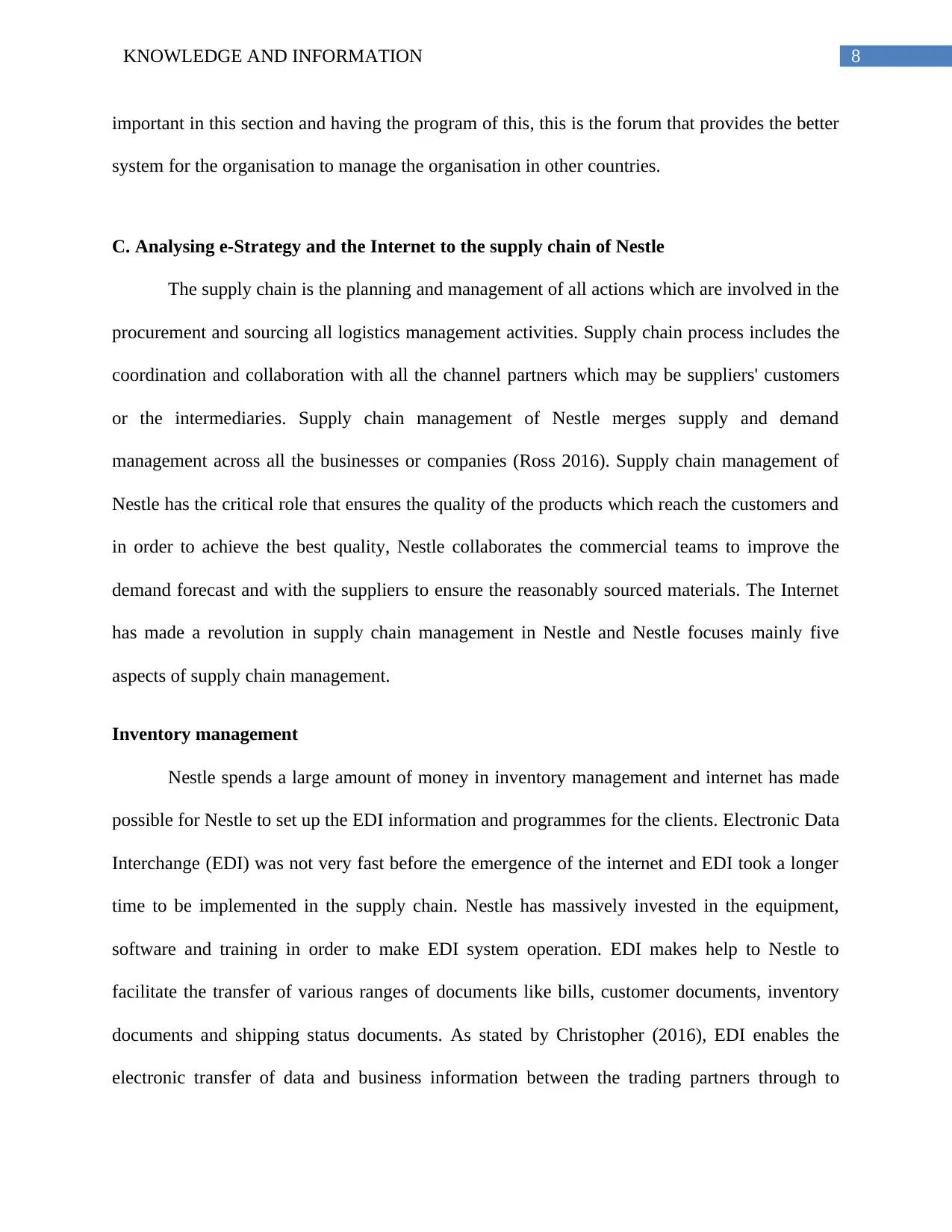
8KNOWLEDGE AND INFORMATION
important in this section and having the program of this, this is the forum that provides the better
system for the organisation to manage the organisation in other countries.
C. Analysing e-Strategy and the Internet to the supply chain of Nestle
The supply chain is the planning and management of all actions which are involved in the
procurement and sourcing all logistics management activities. Supply chain process includes the
coordination and collaboration with all the channel partners which may be suppliers' customers
or the intermediaries. Supply chain management of Nestle merges supply and demand
management across all the businesses or companies (Ross 2016). Supply chain management of
Nestle has the critical role that ensures the quality of the products which reach the customers and
in order to achieve the best quality, Nestle collaborates the commercial teams to improve the
demand forecast and with the suppliers to ensure the reasonably sourced materials. The Internet
has made a revolution in supply chain management in Nestle and Nestle focuses mainly five
aspects of supply chain management.
Inventory management
Nestle spends a large amount of money in inventory management and internet has made
possible for Nestle to set up the EDI information and programmes for the clients. Electronic Data
Interchange (EDI) was not very fast before the emergence of the internet and EDI took a longer
time to be implemented in the supply chain. Nestle has massively invested in the equipment,
software and training in order to make EDI system operation. EDI makes help to Nestle to
facilitate the transfer of various ranges of documents like bills, customer documents, inventory
documents and shipping status documents. As stated by Christopher (2016), EDI enables the
electronic transfer of data and business information between the trading partners through to
important in this section and having the program of this, this is the forum that provides the better
system for the organisation to manage the organisation in other countries.
C. Analysing e-Strategy and the Internet to the supply chain of Nestle
The supply chain is the planning and management of all actions which are involved in the
procurement and sourcing all logistics management activities. Supply chain process includes the
coordination and collaboration with all the channel partners which may be suppliers' customers
or the intermediaries. Supply chain management of Nestle merges supply and demand
management across all the businesses or companies (Ross 2016). Supply chain management of
Nestle has the critical role that ensures the quality of the products which reach the customers and
in order to achieve the best quality, Nestle collaborates the commercial teams to improve the
demand forecast and with the suppliers to ensure the reasonably sourced materials. The Internet
has made a revolution in supply chain management in Nestle and Nestle focuses mainly five
aspects of supply chain management.
Inventory management
Nestle spends a large amount of money in inventory management and internet has made
possible for Nestle to set up the EDI information and programmes for the clients. Electronic Data
Interchange (EDI) was not very fast before the emergence of the internet and EDI took a longer
time to be implemented in the supply chain. Nestle has massively invested in the equipment,
software and training in order to make EDI system operation. EDI makes help to Nestle to
facilitate the transfer of various ranges of documents like bills, customer documents, inventory
documents and shipping status documents. As stated by Christopher (2016), EDI enables the
electronic transfer of data and business information between the trading partners through to
⊘ This is a preview!⊘
Do you want full access?
Subscribe today to unlock all pages.

Trusted by 1+ million students worldwide
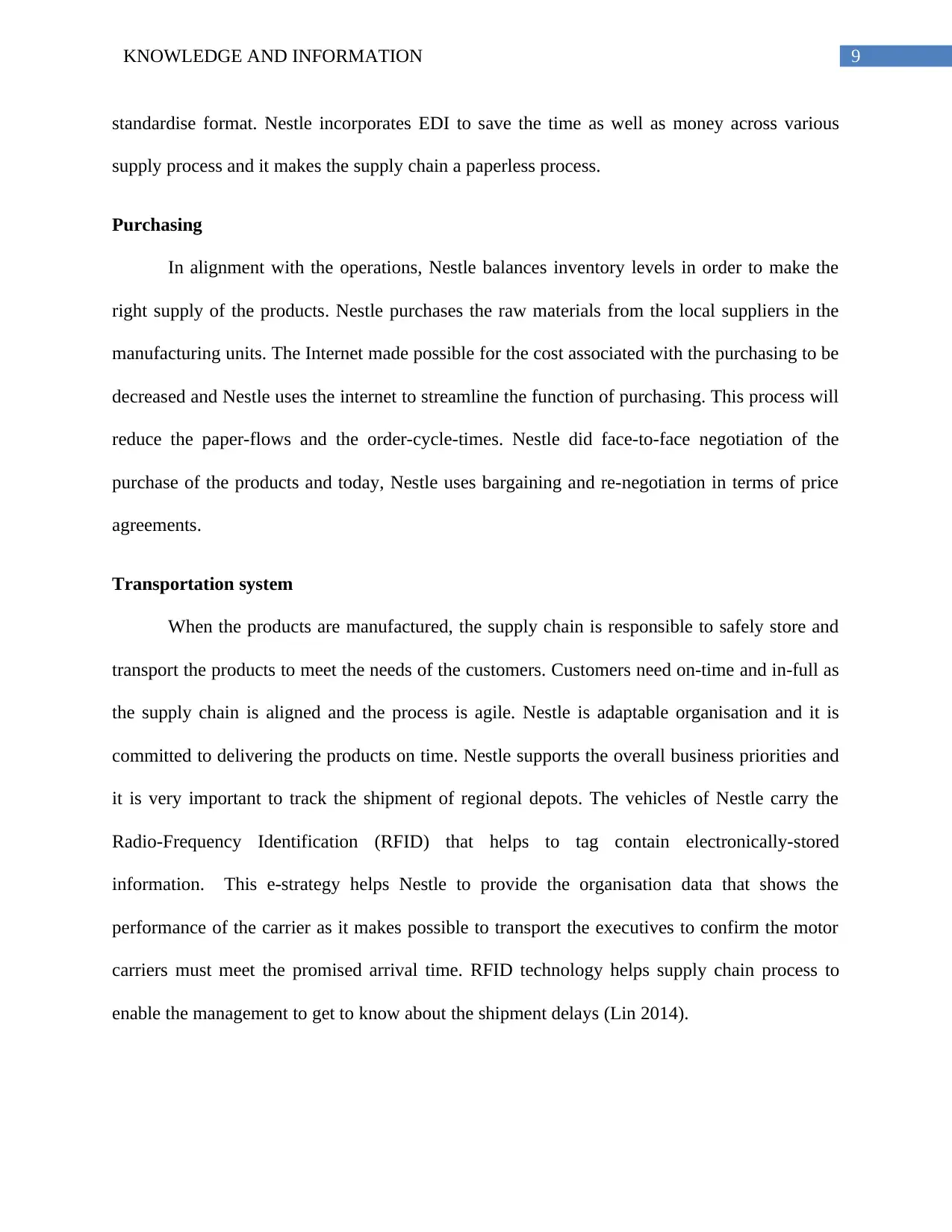
9KNOWLEDGE AND INFORMATION
standardise format. Nestle incorporates EDI to save the time as well as money across various
supply process and it makes the supply chain a paperless process.
Purchasing
In alignment with the operations, Nestle balances inventory levels in order to make the
right supply of the products. Nestle purchases the raw materials from the local suppliers in the
manufacturing units. The Internet made possible for the cost associated with the purchasing to be
decreased and Nestle uses the internet to streamline the function of purchasing. This process will
reduce the paper-flows and the order-cycle-times. Nestle did face-to-face negotiation of the
purchase of the products and today, Nestle uses bargaining and re-negotiation in terms of price
agreements.
Transportation system
When the products are manufactured, the supply chain is responsible to safely store and
transport the products to meet the needs of the customers. Customers need on-time and in-full as
the supply chain is aligned and the process is agile. Nestle is adaptable organisation and it is
committed to delivering the products on time. Nestle supports the overall business priorities and
it is very important to track the shipment of regional depots. The vehicles of Nestle carry the
Radio-Frequency Identification (RFID) that helps to tag contain electronically-stored
information. This e-strategy helps Nestle to provide the organisation data that shows the
performance of the carrier as it makes possible to transport the executives to confirm the motor
carriers must meet the promised arrival time. RFID technology helps supply chain process to
enable the management to get to know about the shipment delays (Lin 2014).
standardise format. Nestle incorporates EDI to save the time as well as money across various
supply process and it makes the supply chain a paperless process.
Purchasing
In alignment with the operations, Nestle balances inventory levels in order to make the
right supply of the products. Nestle purchases the raw materials from the local suppliers in the
manufacturing units. The Internet made possible for the cost associated with the purchasing to be
decreased and Nestle uses the internet to streamline the function of purchasing. This process will
reduce the paper-flows and the order-cycle-times. Nestle did face-to-face negotiation of the
purchase of the products and today, Nestle uses bargaining and re-negotiation in terms of price
agreements.
Transportation system
When the products are manufactured, the supply chain is responsible to safely store and
transport the products to meet the needs of the customers. Customers need on-time and in-full as
the supply chain is aligned and the process is agile. Nestle is adaptable organisation and it is
committed to delivering the products on time. Nestle supports the overall business priorities and
it is very important to track the shipment of regional depots. The vehicles of Nestle carry the
Radio-Frequency Identification (RFID) that helps to tag contain electronically-stored
information. This e-strategy helps Nestle to provide the organisation data that shows the
performance of the carrier as it makes possible to transport the executives to confirm the motor
carriers must meet the promised arrival time. RFID technology helps supply chain process to
enable the management to get to know about the shipment delays (Lin 2014).
Paraphrase This Document
Need a fresh take? Get an instant paraphrase of this document with our AI Paraphraser
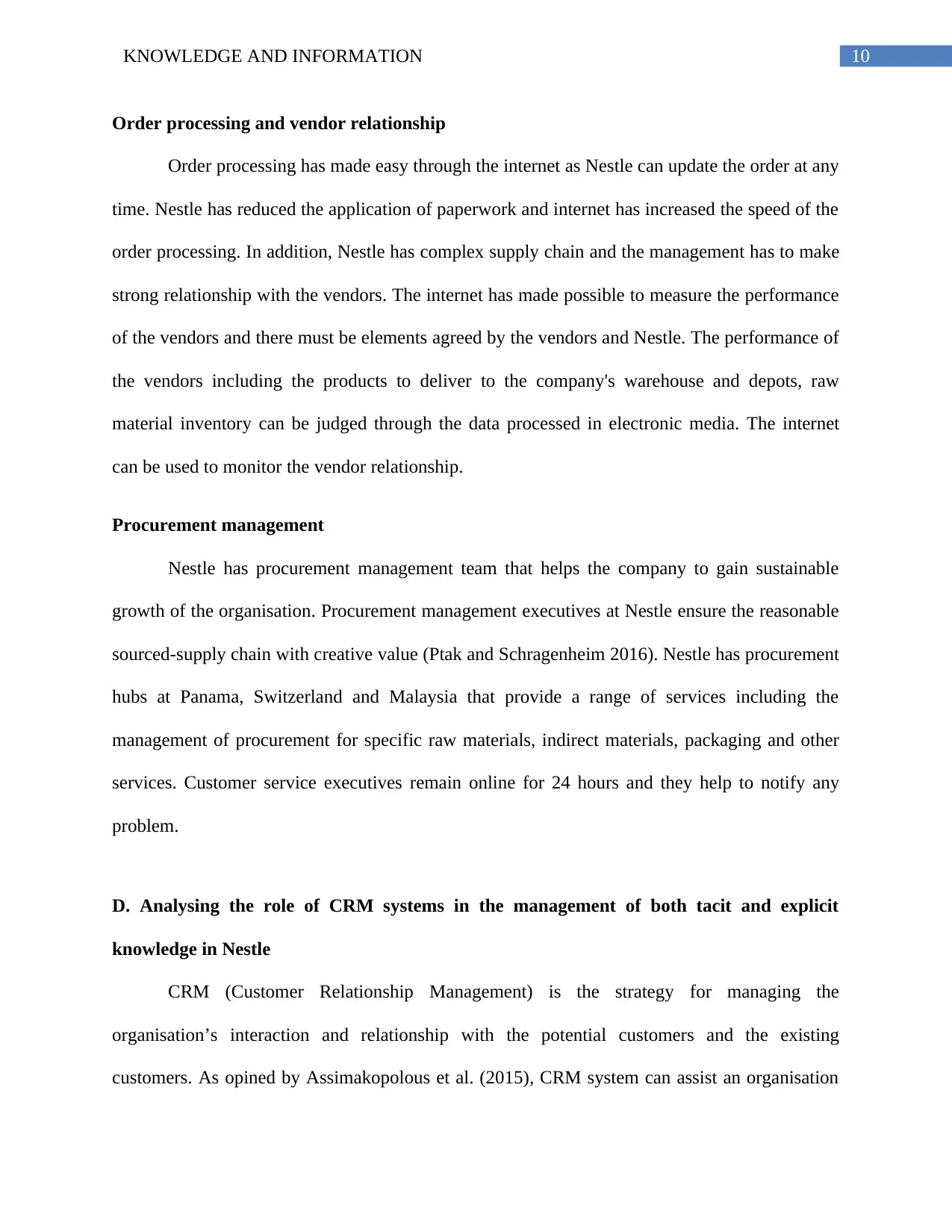
10KNOWLEDGE AND INFORMATION
Order processing and vendor relationship
Order processing has made easy through the internet as Nestle can update the order at any
time. Nestle has reduced the application of paperwork and internet has increased the speed of the
order processing. In addition, Nestle has complex supply chain and the management has to make
strong relationship with the vendors. The internet has made possible to measure the performance
of the vendors and there must be elements agreed by the vendors and Nestle. The performance of
the vendors including the products to deliver to the company's warehouse and depots, raw
material inventory can be judged through the data processed in electronic media. The internet
can be used to monitor the vendor relationship.
Procurement management
Nestle has procurement management team that helps the company to gain sustainable
growth of the organisation. Procurement management executives at Nestle ensure the reasonable
sourced-supply chain with creative value (Ptak and Schragenheim 2016). Nestle has procurement
hubs at Panama, Switzerland and Malaysia that provide a range of services including the
management of procurement for specific raw materials, indirect materials, packaging and other
services. Customer service executives remain online for 24 hours and they help to notify any
problem.
D. Analysing the role of CRM systems in the management of both tacit and explicit
knowledge in Nestle
CRM (Customer Relationship Management) is the strategy for managing the
organisation’s interaction and relationship with the potential customers and the existing
customers. As opined by Assimakopolous et al. (2015), CRM system can assist an organisation
Order processing and vendor relationship
Order processing has made easy through the internet as Nestle can update the order at any
time. Nestle has reduced the application of paperwork and internet has increased the speed of the
order processing. In addition, Nestle has complex supply chain and the management has to make
strong relationship with the vendors. The internet has made possible to measure the performance
of the vendors and there must be elements agreed by the vendors and Nestle. The performance of
the vendors including the products to deliver to the company's warehouse and depots, raw
material inventory can be judged through the data processed in electronic media. The internet
can be used to monitor the vendor relationship.
Procurement management
Nestle has procurement management team that helps the company to gain sustainable
growth of the organisation. Procurement management executives at Nestle ensure the reasonable
sourced-supply chain with creative value (Ptak and Schragenheim 2016). Nestle has procurement
hubs at Panama, Switzerland and Malaysia that provide a range of services including the
management of procurement for specific raw materials, indirect materials, packaging and other
services. Customer service executives remain online for 24 hours and they help to notify any
problem.
D. Analysing the role of CRM systems in the management of both tacit and explicit
knowledge in Nestle
CRM (Customer Relationship Management) is the strategy for managing the
organisation’s interaction and relationship with the potential customers and the existing
customers. As opined by Assimakopolous et al. (2015), CRM system can assist an organisation
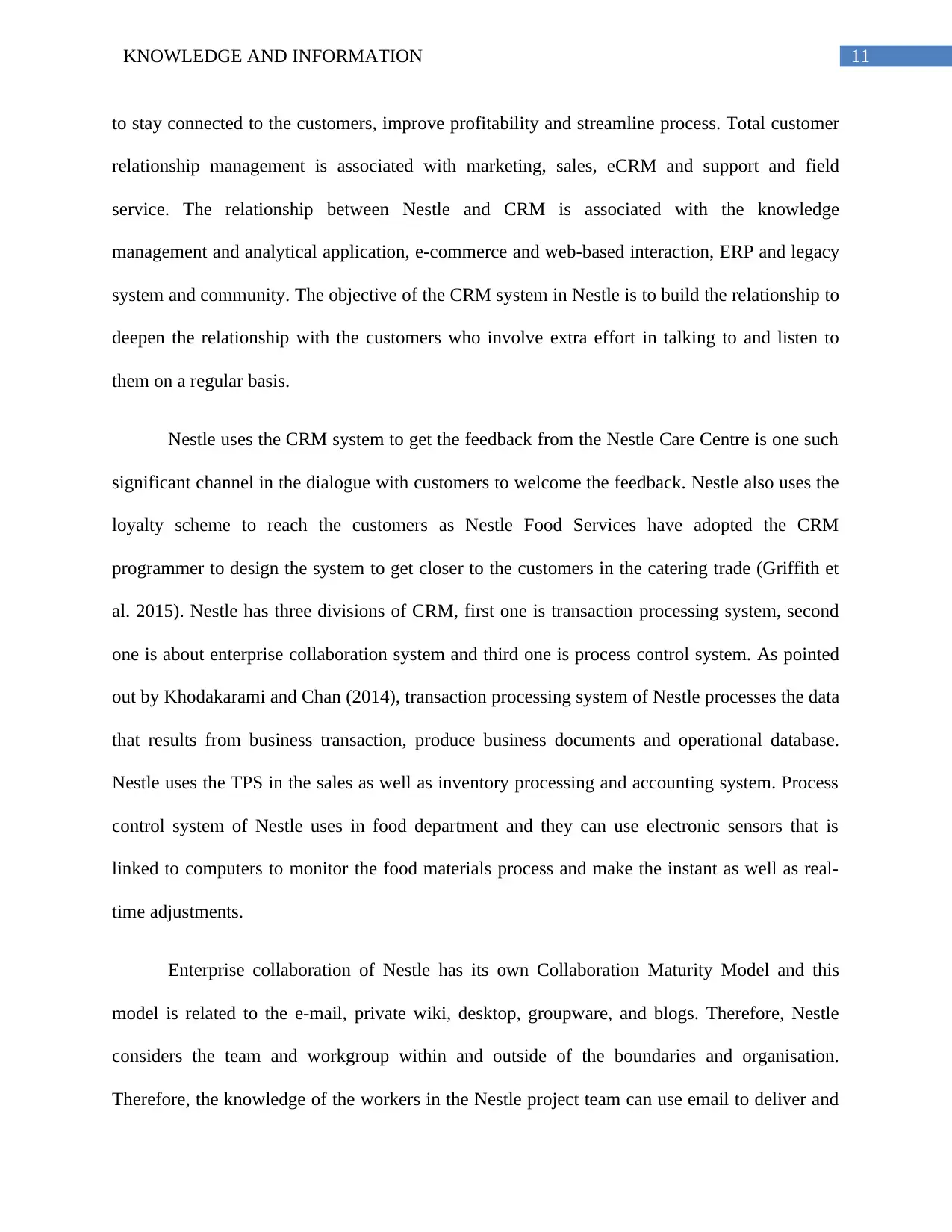
11KNOWLEDGE AND INFORMATION
to stay connected to the customers, improve profitability and streamline process. Total customer
relationship management is associated with marketing, sales, eCRM and support and field
service. The relationship between Nestle and CRM is associated with the knowledge
management and analytical application, e-commerce and web-based interaction, ERP and legacy
system and community. The objective of the CRM system in Nestle is to build the relationship to
deepen the relationship with the customers who involve extra effort in talking to and listen to
them on a regular basis.
Nestle uses the CRM system to get the feedback from the Nestle Care Centre is one such
significant channel in the dialogue with customers to welcome the feedback. Nestle also uses the
loyalty scheme to reach the customers as Nestle Food Services have adopted the CRM
programmer to design the system to get closer to the customers in the catering trade (Griffith et
al. 2015). Nestle has three divisions of CRM, first one is transaction processing system, second
one is about enterprise collaboration system and third one is process control system. As pointed
out by Khodakarami and Chan (2014), transaction processing system of Nestle processes the data
that results from business transaction, produce business documents and operational database.
Nestle uses the TPS in the sales as well as inventory processing and accounting system. Process
control system of Nestle uses in food department and they can use electronic sensors that is
linked to computers to monitor the food materials process and make the instant as well as real-
time adjustments.
Enterprise collaboration of Nestle has its own Collaboration Maturity Model and this
model is related to the e-mail, private wiki, desktop, groupware, and blogs. Therefore, Nestle
considers the team and workgroup within and outside of the boundaries and organisation.
Therefore, the knowledge of the workers in the Nestle project team can use email to deliver and
to stay connected to the customers, improve profitability and streamline process. Total customer
relationship management is associated with marketing, sales, eCRM and support and field
service. The relationship between Nestle and CRM is associated with the knowledge
management and analytical application, e-commerce and web-based interaction, ERP and legacy
system and community. The objective of the CRM system in Nestle is to build the relationship to
deepen the relationship with the customers who involve extra effort in talking to and listen to
them on a regular basis.
Nestle uses the CRM system to get the feedback from the Nestle Care Centre is one such
significant channel in the dialogue with customers to welcome the feedback. Nestle also uses the
loyalty scheme to reach the customers as Nestle Food Services have adopted the CRM
programmer to design the system to get closer to the customers in the catering trade (Griffith et
al. 2015). Nestle has three divisions of CRM, first one is transaction processing system, second
one is about enterprise collaboration system and third one is process control system. As pointed
out by Khodakarami and Chan (2014), transaction processing system of Nestle processes the data
that results from business transaction, produce business documents and operational database.
Nestle uses the TPS in the sales as well as inventory processing and accounting system. Process
control system of Nestle uses in food department and they can use electronic sensors that is
linked to computers to monitor the food materials process and make the instant as well as real-
time adjustments.
Enterprise collaboration of Nestle has its own Collaboration Maturity Model and this
model is related to the e-mail, private wiki, desktop, groupware, and blogs. Therefore, Nestle
considers the team and workgroup within and outside of the boundaries and organisation.
Therefore, the knowledge of the workers in the Nestle project team can use email to deliver and
⊘ This is a preview!⊘
Do you want full access?
Subscribe today to unlock all pages.

Trusted by 1+ million students worldwide
1 out of 17
Related Documents
Your All-in-One AI-Powered Toolkit for Academic Success.
+13062052269
info@desklib.com
Available 24*7 on WhatsApp / Email
![[object Object]](/_next/static/media/star-bottom.7253800d.svg)
Unlock your academic potential
Copyright © 2020–2025 A2Z Services. All Rights Reserved. Developed and managed by ZUCOL.





